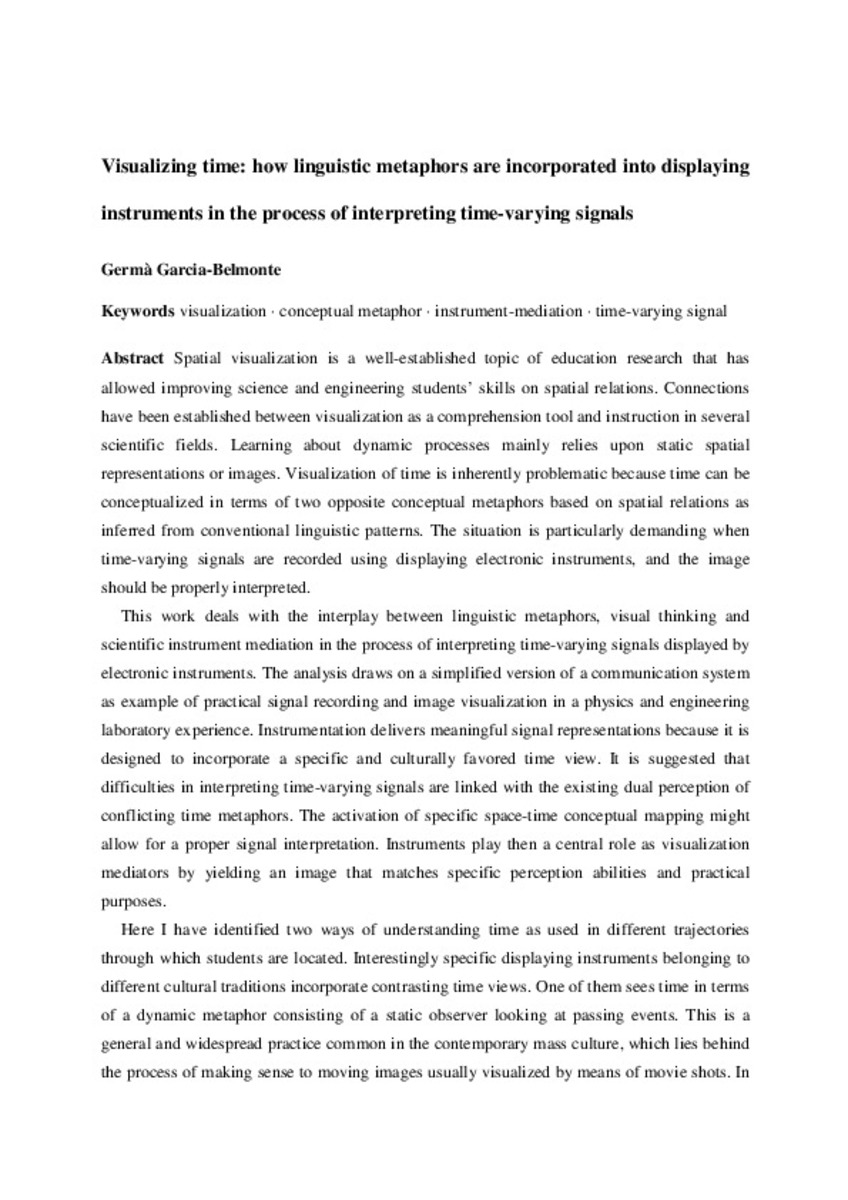Mostrar el registro sencillo del ítem
Visualizing time: how linguistic metaphors are incorporated into displaying instruments in the process of interpreting time-varying signals
| dc.contributor.author | Garcia-Belmonte, Germà | |
| dc.date.accessioned | 2018-03-14T10:09:19Z | |
| dc.date.available | 2018-03-14T10:09:19Z | |
| dc.date.issued | 2017 | |
| dc.identifier.citation | GARCIA-BELMONTE, Germà. Visualizing time: how linguistic metaphors are incorporated into displaying instruments in the process of interpreting time-varying signals. Cultural Studies of Science Education, 2017, vol. 12, no 2, p. 369-385. | ca_CA |
| dc.identifier.issn | 1871-1502 | |
| dc.identifier.issn | 1871-1510 | |
| dc.identifier.uri | http://hdl.handle.net/10234/173366 | |
| dc.description.abstract | Spatial visualization is a well-established topic of education research that has allowed improving science and engineering students’ skills on spatial relations. Connections have been established between visualization as a comprehension tool and instruction in several scientific fields. Learning about dynamic processes mainly relies upon static spatial representations or images. Visualization of time is inherently problematic because time can be conceptualized in terms of two opposite conceptual metaphors based on spatial relations as inferred from conventional linguistic patterns. The situation is particularly demanding when time-varying signals are recorded using displaying electronic instruments, and the image should be properly interpreted. This work deals with the interplay between linguistic metaphors, visual thinking and scientific instrument mediation in the process of interpreting time-varying signals displayed by electronic instruments. The analysis draws on a simplified version of a communication system as example of practical signal recording and image visualization in a physics and engineering laboratory experience. Instrumentation delivers meaningful signal representations because it is designed to incorporate a specific and culturally favored time view. It is suggested that difficulties in interpreting time-varying signals are linked with the existing dual perception of conflicting time metaphors. The activation of specific space–time conceptual mapping might allow for a proper signal interpretation. Instruments play then a central role as visualization mediators by yielding an image that matches specific perception abilities and practical purposes. Here I have identified two ways of understanding time as used in different trajectories through which students are located. Interestingly specific displaying instruments belonging to different cultural traditions incorporate contrasting time views. One of them sees time in terms of a dynamic metaphor consisting of a static observer looking at passing events. This is a general and widespread practice common in the contemporary mass culture, which lies behind the process of making sense to moving images usually visualized by means of movie shots. In contrast scientific culture favored another way of time conceptualization (static time metaphor) that historically fostered the construction of graphs and the incorporation of time-dependent functions, as represented on the Cartesian plane, into displaying instruments. Both types of cultures, scientific and mass, are considered highly technological in the sense that complex instruments, apparatus or machines participate in their visual practices. | ca_CA |
| dc.format.extent | 17 p. | ca_CA |
| dc.format.mimetype | application/pdf | ca_CA |
| dc.language.iso | eng | ca_CA |
| dc.relation.isPartOf | Cultural Studies of Science Education, 2017, vol. 12, no 2 | ca_CA |
| dc.rights | © Springer Science+Business Media Dordrecht. This is a pre-print of an article published in Cultural Studies of Science Education. The final authenticated version is available online at: https://doi.org/10.1007/s11422-015-9686-4 | ca_CA |
| dc.rights.uri | http://rightsstatements.org/vocab/InC/1.0/ | * |
| dc.subject | visualization | ca_CA |
| dc.subject | conceptual metaphor | ca_CA |
| dc.subject | instrument-mediation | ca_CA |
| dc.subject | time-varying signal | ca_CA |
| dc.title | Visualizing time: how linguistic metaphors are incorporated into displaying instruments in the process of interpreting time-varying signals | ca_CA |
| dc.type | info:eu-repo/semantics/article | ca_CA |
| dc.identifier.doi | https://doi.org/10.1007/s11422-015-9686-4 | |
| dc.rights.accessRights | info:eu-repo/semantics/openAccess | ca_CA |
| dc.relation.publisherVersion | https://link.springer.com/article/10.1007/s11422-015-9686-4 | ca_CA |
| dc.type.version | info:eu-repo/semantics/submittedVersion | ca_CA |
Ficheros en el ítem
Este ítem aparece en la(s) siguiente(s) colección(ones)
-
FCA_Articles [501]
Articles de publicacions periódiques







